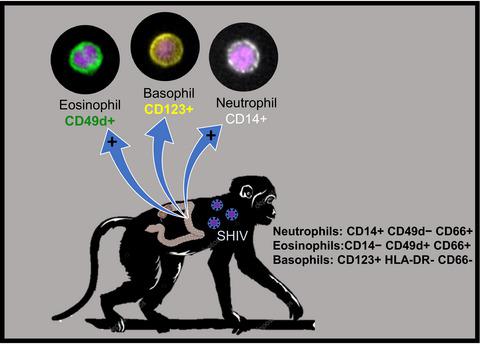当前位置:
X-MOL 学术
›
Immunology
›
论文详情
Our official English website, www.x-mol.net, welcomes your
feedback! (Note: you will need to create a separate account there.)
Systemic and mucosal mobilization of granulocyte subsets during lentiviral infection
Immunology ( IF 4.9 ) Pub Date : 2021-05-26 , DOI: 10.1111/imm.13376 Rhianna Jones 1 , Cordelia Manickam 1 , Daniel R Ram 1 , Kyle Kroll 1 , Brady Hueber 1 , Griffin Woolley 1 , Spandan V Shah 1 , Scott Smith 1 , Valerie Varner 1 , R Keith Reeves 1, 2, 3
Immunology ( IF 4.9 ) Pub Date : 2021-05-26 , DOI: 10.1111/imm.13376 Rhianna Jones 1 , Cordelia Manickam 1 , Daniel R Ram 1 , Kyle Kroll 1 , Brady Hueber 1 , Griffin Woolley 1 , Spandan V Shah 1 , Scott Smith 1 , Valerie Varner 1 , R Keith Reeves 1, 2, 3
Affiliation

|
Granulocytes mediate broad immunoprotection through phagocytosis, extracellular traps, release of cytotoxic granules, antibody effector functions and recruitment of other immune cells against pathogens. However, descriptions of granulocytes in HIV infection and mucosal tissues are limited. Our goal was to characterize granulocyte subsets in systemic, mucosal and lymphoid tissues during lentiviral infection using the rhesus macaque (RM) model. Mononuclear cells from jejunum, colon, cervix, vagina, lymph nodes, spleen, liver and whole blood from experimentally naïve and chronically SHIVsf162p3-infected RM were analysed by microscopy and polychromatic flow cytometry. Granulocytes were identified using phenotypes designed specifically for RM: eosinophils—CD45+ CD66+ CD49d+; neutrophils—CD45+ CD66+ CD14+; and basophils—CD45+ CD123+ FcRε+. Nuclear visualization with DAPI staining and surface marker images by ImageStream (cytometry/microscopy) further confirmed granulocytic phenotypes. Flow cytometric data showed that all RM granulocytes expressed CD32 (FcRγII) but did not express CD16 (FcRγIII). Additionally, constitutive expression of CD64 (FcRγI) on neutrophils and FcRε on basophils indicates the differential expression of Fc receptors on granulocyte subsets. Granulocytic subsets in naïve whole blood ranged from 25·4% to 81·5% neutrophils, 0·59% to 13·3% eosinophils and 0·059% to 1·8% basophils. Interestingly, elevated frequencies of circulating neutrophils, colorectal neutrophils and colorectal eosinophils were all observed in chronic lentiviral disease. Conversely, circulating basophils, jejunal eosinophils, vaginal neutrophils and vaginal eosinophils of SHIVsf162p3-infected RM declined in frequency. Overall, our data suggest modulation of granulocytes in chronic lentiviral infection, most notably in the gastrointestinal mucosae where a significant inflammation and disruption occurs in lentivirus-induced disease. Furthermore, granulocytes may migrate to inflamed tissues during infection and could serve as targets of immunotherapeutic intervention.
中文翻译:

慢病毒感染期间粒细胞亚群的全身和粘膜动员
粒细胞通过吞噬作用、细胞外陷阱、细胞毒性颗粒的释放、抗体效应功能和针对病原体的其他免疫细胞的募集来介导广泛的免疫保护。然而,对 HIV 感染和粘膜组织中粒细胞的描述是有限的。我们的目标是使用恒河猴 (RM) 模型来表征慢病毒感染期间全身、粘膜和淋巴组织中的粒细胞亚群。通过显微镜和多色流式细胞术分析来自空肠、结肠、子宫颈、阴道、淋巴结、脾脏、肝脏和来自实验初始和长期感染 SHIVsf162p3 的 RM 的全血的单核细胞。使用专为 RM 设计的表型来鉴定粒细胞:嗜酸性粒细胞 — CD45 + CD66 + CD49d +;中性粒细胞—CD45 + CD66 + CD14 + ; 和嗜碱性粒细胞 —CD45 + CD123 + FcRε +。通过 DAPI 染色和 ImageStream(细胞计数/显微镜)表面标记图像进行核可视化进一步证实了粒细胞表型。流式细胞术数据显示,所有 RM 粒细胞均表达 CD32 (FcRγII),但不表达 CD16 (FcRγIII)。此外,中性粒细胞上 CD64 (FcRγI) 和嗜碱性粒细胞上 FcRε 的组成型表达表明粒细胞亚群上 Fc 受体的差异表达。初始全血中的粒细胞亚群范围为 25·4% 至 81·5% 中性粒细胞、0·59% 至 13·3% 嗜酸性粒细胞和 0·059% 至 1·8% 嗜碱性粒细胞。有趣的是,在慢性慢病毒性疾病中,循环中性粒细胞、结直肠中性粒细胞和结直肠嗜酸性粒细胞的频率均升高。相反,SHIVsf162p3感染的RM的循环嗜碱性粒细胞、空肠嗜酸性粒细胞、阴道中性粒细胞和阴道嗜酸性粒细胞的频率下降。总体而言,我们的数据表明慢性慢病毒感染中粒细胞的调节,尤其是在胃肠道粘膜中,在慢病毒诱导的疾病中发生显着的炎症和破坏。此外,粒细胞在感染过程中可能会迁移到发炎组织,并可以作为免疫治疗干预的目标。
更新日期:2021-05-26
中文翻译:

慢病毒感染期间粒细胞亚群的全身和粘膜动员
粒细胞通过吞噬作用、细胞外陷阱、细胞毒性颗粒的释放、抗体效应功能和针对病原体的其他免疫细胞的募集来介导广泛的免疫保护。然而,对 HIV 感染和粘膜组织中粒细胞的描述是有限的。我们的目标是使用恒河猴 (RM) 模型来表征慢病毒感染期间全身、粘膜和淋巴组织中的粒细胞亚群。通过显微镜和多色流式细胞术分析来自空肠、结肠、子宫颈、阴道、淋巴结、脾脏、肝脏和来自实验初始和长期感染 SHIVsf162p3 的 RM 的全血的单核细胞。使用专为 RM 设计的表型来鉴定粒细胞:嗜酸性粒细胞 — CD45 + CD66 + CD49d +;中性粒细胞—CD45 + CD66 + CD14 + ; 和嗜碱性粒细胞 —CD45 + CD123 + FcRε +。通过 DAPI 染色和 ImageStream(细胞计数/显微镜)表面标记图像进行核可视化进一步证实了粒细胞表型。流式细胞术数据显示,所有 RM 粒细胞均表达 CD32 (FcRγII),但不表达 CD16 (FcRγIII)。此外,中性粒细胞上 CD64 (FcRγI) 和嗜碱性粒细胞上 FcRε 的组成型表达表明粒细胞亚群上 Fc 受体的差异表达。初始全血中的粒细胞亚群范围为 25·4% 至 81·5% 中性粒细胞、0·59% 至 13·3% 嗜酸性粒细胞和 0·059% 至 1·8% 嗜碱性粒细胞。有趣的是,在慢性慢病毒性疾病中,循环中性粒细胞、结直肠中性粒细胞和结直肠嗜酸性粒细胞的频率均升高。相反,SHIVsf162p3感染的RM的循环嗜碱性粒细胞、空肠嗜酸性粒细胞、阴道中性粒细胞和阴道嗜酸性粒细胞的频率下降。总体而言,我们的数据表明慢性慢病毒感染中粒细胞的调节,尤其是在胃肠道粘膜中,在慢病毒诱导的疾病中发生显着的炎症和破坏。此外,粒细胞在感染过程中可能会迁移到发炎组织,并可以作为免疫治疗干预的目标。









































 京公网安备 11010802027423号
京公网安备 11010802027423号